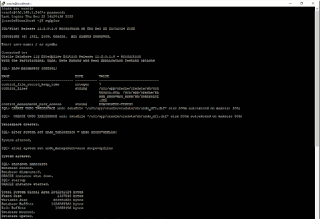Error log:
[oracle@localhost ~]$ sqlplus
Enter user-name: / as sysdba
SQL> shutdown abort;
SQL> startup nomount;
ORA-01507: database not mounted
SQL> shutdown abort;
alter database open resetlogs
*
ERROR at line 1:
ORA-01194: file 1 needs more recovery to be consistent
ORA-01110: data file 1:
'/u01/app/oracle/oradata/RTS_NEW/system_new.dbf'
Workaround for this error is to provide all the available
archive log files to the recovery:
SQL> recover database using backup controlfile until
cancel;
...
Specify log: {<RET>=suggested | filename | AUTO |
CANCEL}
AUTO
Above command will apply all the available archive logs
automatically. Now try to open database with resetlogs:
SQL> alter database open resetlogs;
If the error persists due to insufficient archive logs, do
the following workaround:
SQL> shutdown immediate
ORA-01109: database not open
Database dismounted.
ORACLE instance shut down.
Startup database in mount mode:
SQL> startup mount
ORACLE instance started.
Total System Global Area 530288640 bytes
Fixed Size 2131120 bytes
Variable Size 310381392 bytes
Database Buffers 209715200 bytes
Redo Buffers 8060928 bytes
Database mounted.
Change “_allow_resetlogs_corruption” parameter to TRUE
and undo_management parameter to MANUAL:
SQL> ALTER SYSTEM SET
"_allow_resetlogs_corruption"= TRUE SCOPE = SPFILE;
SQL> ALTER SYSTEM SET undo_management=MANUAL SCOPE =
SPFILE;
After doing above changes, shutdown database, and startup:
SQL> shutdown immediate
ORA-01109: database not open
Database dismounted.
ORACLE instance shut down.
SQL> startup mount
ORACLE instance started.
Total System Global Area 530288640 bytes
Fixed Size 2131120 bytes
Variable Size 310381392 bytes
Database Buffers 209715200 bytes
Redo Buffers 8060928 bytes
Database mounted.
Now try resetlogs:
SQL> alter database open resetlogs;
Database altered.
SQL> shutdown immediate
ORA-01109: database not open
Database dismounted.
ORACLE instance shut down.
SQL> startup
When database started successfully and up then perform the
following steps
Create new undo tablespace and set “undo_tablespace”
parameter to the new undo tablespace and change “undo_management”
parameter to AUTO:
Undo space once allocated will be available for reuse but
will not be deallocated to the OS. The best way to shrink Undo tablespace is to
switch to a new Undo tablespace and drop the old Undo tablespace. The steps
are:
1. Create a new undo tablespace of the same size (larger or
smaller) depending on your database requirements.
SQL> show parameter control;
SQL> CREATE UNDO TABLESPACE undo datafile
'/u01/app/oracle/oradata/sa/undo_df1.dbf' size 200m autoextend on maxsize 30G;
Tablespace created.
SQL> alter system set undo_tablespace = undo
scope=spfile;
System altered.
SQL> alter system set undo_management=auto scope=spfile;
System altered.
SQL> shutdown immediate
SQL> startup
Cheers!! Database started successfully.
Check the status of the undo segments and determine if all the segments in the old undo tablespace are offline.
sql> select tablespace_name, status, count(*) from dba_rollback_segs group by tablespace_name, status;
TABLESPACE_NAME STATUS COUNT(*)
------------------------------ ---------------- ----------
UNDOTBS1 OFFLINE 10
SYSTEM ONLINE 1
UNDO ONLINE 10
If there are Undo segments with a status other than OFFLINE
in the tablespace to be dropped, we need to wait till they become OFFLINE. You
may have to wait for the duration of the tuned_undoretention (from v$undostat)
to ensure all Undo segments have become OFFLINE.
sql> select status,segment_name from dba_rollback_segs
where status not in ('OFFLINE') and tablespace_name=UNDOTBS1;
sql> select status,segment_name from dba_rollback_segs where status not in ('OFFLINE') and tablespace_name='UNDO';
For example:
sql> select status,segment_name from dba_rollback_segs
where status not in ('OFFLINE') and tablespace_name='UNDOTBS1';
If all the Undo segments in the old Undo tablespace to the
dropped is of status OFFLINE, then drop the tablespace.
sql> select tablespace_name, status, count(*) from
dba_rollback_segs group by tablespace_name, status;
Verify and then drop:
sql> drop tablespace [tablespace_name] including contents
and datafiles;
For example:
sql> drop tablespace UNDOTBS1 including contents and
datafiles;
Tablespace dropped.
SQL> select tablespace_name, status, count(*) from dba_rollback_segs group by tablespace_name, status;
TABLESPACE_NAME STATUS COUNT(*)
------------------------------ ---------------- ----------
SYSTEM ONLINE 1
UNDO ONLINE 10
SQL>




No comments:
Post a Comment